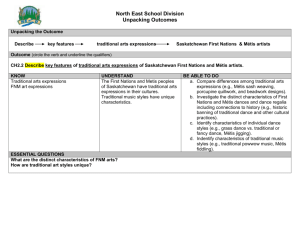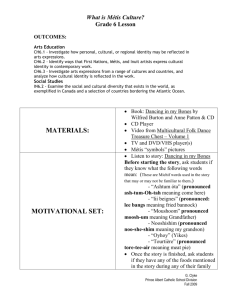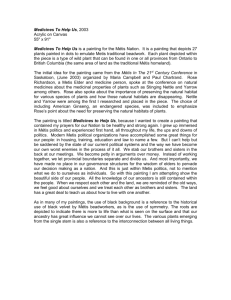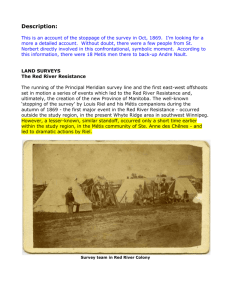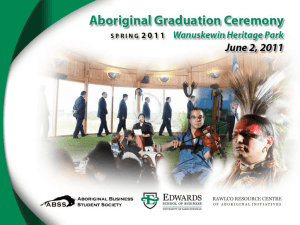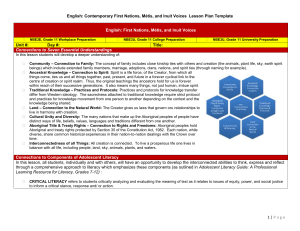Métis PowerPoint English - Legacy of Hope Foundation
advertisement
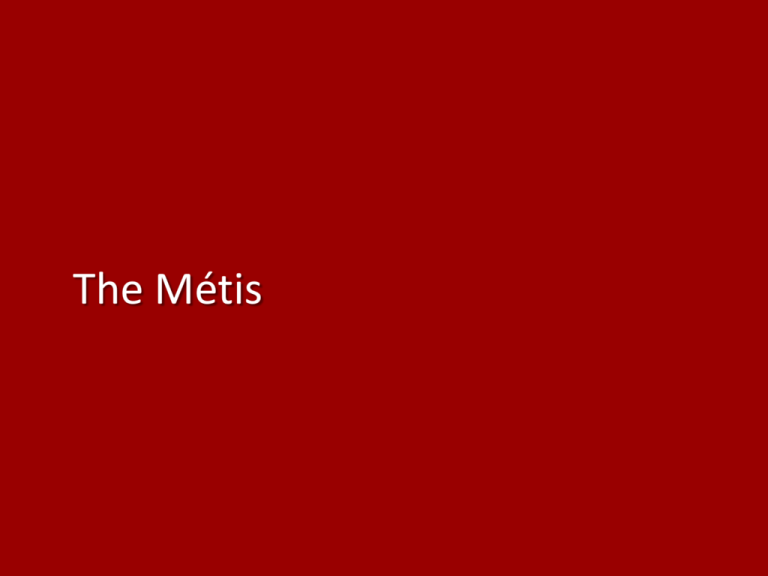
The Métis Who are the Métis? The Métis are one of three Aboriginal groups in Canada originating in the fur trade era, primarily in Western Canada. Métis are neither Indian nor European, but both; the offspring of First Nations and the employees of the Hudson’s Bay and North West Companies. The children of these mixed relationships became the mothers and fathers of the Métis Nation. Today the term Métis is used to describe individuals of French, Scottish, English, and First Nations ancestry. In the past, terms such as Half-breed, Bois-Brûles (burnt wood), country-born, Michif, Otipaimsiwauk, and Apeetokosisan were also used. Many Métis community members spoke (and continue to speak) unique languages called Michif and Bungi as well as a variety of First Nations languages, French and English. The Flower Beadwork People Known for their artistry, the Métis were sometimes called The Flower Beadwork People. The distinctive Métis language, Michif, combines Cree and French. Bungi or Bungee is a Métis language that combines Gaelic and Cree mixed with French and Saulteaux. Métis fiddlers incorporated jigs and reels into their music to produce their own unique style of music. A New Nation A rapid and dramatic cultural evolution began in the mid 1600’s and by the mid 1800’s, a new people was emerging. The Métis considered themselves a new Nation, complete with flag, language, clothing, music, and dance. Métis built and used Red River carts, an important Métis cultural icon, for buffalo hunts. In the early 1800’s, the Métis challenged the Hudson’s Bay Company monopoly in the fur trade. By 1869, the population of the Red River Settlement consisted of 5,720 Francophone Métis, 4,080 Anglophone Métis and 1,600 non-natives. Change is coming… In 1869, the Hudson’s Bay Company sold its right to Rupert’s Land to the Dominion of Canada for a small sum of money and 1/20th of the territory’s fertile land. In October of 1869, a Métis Provisional Government headed by Louis Riel carried a List of Rights to the Canadian government in Ottawa, ON. The list formed the basis of negotiations with Sir John A. Macdonald’s Tories. On July 15, 1870, Louis Riel effectively brought the Province of Manitoba into Confederation. Louis Riel – Father of Confederation? Although twice elected to the House of Commons, Riel was prevented from serving due to a motion declaring him an outlaw. Riel was forced into exile and relocated to Montana in the USA. Battle of Batoche Federal promises of land in the Manitoba Act were not fulfilled and the government introduced its notorious scrip system. The settlement of the West set in motion a series of events that culminated in the 1885 defeat of the Métis, then led by Louis Riel and Gabriel Dumont. Today, this battle at Batoche, Saskatchewan is still referred to as la guerre Nationale by Métis. This marked the first time a Gatling gun was used against a people. Riel surrendered and stood trial for treason. He was found guilty and was sentenced to death by hanging. Gatling Gun The Bell of Batoche The Bell of Batoche is a symbol of Métis culture. During the 1885 Resistance, a bell was stolen by three government soldiers and taken to Millbrook, Ontario. It was used as the fire hall bell and then put on display at the local Royal Canadian Legion Branch. In 1991, the bell was taken from Millbrook and in July 2013 it was repatriated to the Métis in a special ceremony. Questions about the bell’s authenticity ensued until April 2014 when the Director of Le Musée de Saint-Boniface, Philippe Mailhot, acknowledged that there was enough evidence to conclude that it was actually the Bell of Frog Lake taken from the Frog Lake Mission in 1885. The actual Bell of Batoche was been donated to a church in St. Laurent de Grandin where it melted during a fire that destroyed the church. North West Half-Breed Commission The federal government took the position that Métis Aboriginal title was extinguished by the issuance of land, scrip and cash grants to Métis from 1875 to 1924. 95.9% of land scrip notes issued were assigned to another party and 84.6% of money scrip notes appear to have been procured by speculators. Even though Métis were being defrauded of their land, such abuse was ignored and perhaps facilitated by the government. Continued harassment led to the mass dispersion of Métis peoples, ending a chapter in the political life of the Métis. A People Scattered Between 1876 and 1884, two-thirds of Métis people moved out of Manitoba. Many headed further northwest and southwest, including into the present day United States. Residential Schools Beginning in the mid-1800s and continuing into the late 1990s, Aboriginal children, some as young as 4 years old, were taken from their homes and communities and placed in institutions called residential schools. These church-run schools were funded by the Canadian government as a key component in a larger policy of assimilation. Separated from their families and prohibited from speaking their languages and practicing their culture, the over 150,000 children in these schools were vulnerable and many suffered abuses of the mind, body and spirit. It is estimated that 10% of the children that were taken to residential schools were Métis and their experience was unique and different to that of First Nations children. HOW DID RS IMPACT THE MÉTIS? Métis attendance at residential schools varied from school to school. Métis children were sometimes unrecorded or not distinguished from First Nations children in school records. Frequently regarded as outsiders, Métis children were often treated differently, sometimes better, sometimes worse. Some were made to work longer and harder to ‘earn’ their education. The Department of Indian Affairs classified Métis children as first, second or third-class Halfbreeds according to lifestyle and appearance. Métis parents wanted their children to receive a Euro-Canadian education and residential schools were often the only option. Often overlooked or marginalized in historical accounts and not eligible for compensation unless they could prove they attended a school recognized by the Indian Residential School Settlement Agreement, the Métis today continue to seek recognition and compensation for abuses suffered in both the residential and day school systems. Identity Many Métis went underground, others stayed quiet and those who buried their heritage became difficult to identify. An awakening political movement brought out the importance of cultural identity and a desire to be recognized as a people. Federal or Provincial? The federal and provincial governments claim to support Métis self-government. However, the provincial position is that the Métis are a federal responsibility and the federal government takes the position that Métis are a provincial responsibility. On September 19, 2003, the Supreme Court affirmed that s. 35 is a substantive promise to the Métis which recognizes their distinct existence and protects their existing Aboriginal rights. *R. v. Powley On January 8, 2013, the Federal Court ruled that 200,000 Métis and 400,000 nonstatus Indians in Canada are indeed "Indians" under the Constitution Act, and fall under federal jurisdiction. "The recognition of Métis and non-status Indian as Indians under section 91(24) should accord a further level of respect and reconciliation by removing the constitutional uncertainty surrounding these groups," Federal Court Judge Michael Phelan wrote. Update – Supreme Court Decision On March 8, 2013 the Supreme Court ruled that the federal government was "ineffectual and inequitable" in how it handed out land to Métis children in Manitoba more than 130 years ago. The case stemmed from Manitoba's entry into Confederation in 1870. In negotiations with the Métis, Canada agreed to deliver 1.4 million acres of land (section 31 of the Manitoba Act). The Manitoba Metis Federation (MMF) argued the crown never lived up to its obligation and that delays and mistakes meant the land was never fully delivered as promised. The MMF won its argument in a 6-2 decision by the Supreme Court. Demographics Métis Demographics According to the 2006 census, Métis account for 34% of the Aboriginal population. This population has almost doubled (increasing by 91%) since 1996 and 33% between 2001 and 2006, compared to 5% for all of Canada. About 87% of Métis lived in either the western provinces or Ontario. Largest Métis populations by city: Winnipeg- 40,980 Edmonton - 27,740 Vancouver - 15,070 Calgary - 14,770 Saskatoon - 9,610 The urban centre with the highest concentration of Métis people was Prince Albert, Saskatchewan, where about 1 out of 6 (17%) residents were Métis. The Métis population is young. In 2006, the median age of Métis was 30 years - nine years younger than that for the total Canadian population. This data is important when interpreting any changes in health, social, and economic status over time. Aboriginal Peoples Survey, 2006: An overview of the health of the Métis population Education In 2006, Métis aged 25 to 54 were more likely (24%) than those in the total population of Canada to have less than a high school diploma (13%). Similar percentages of Métis and the total population of Canada aged 25 to 54 had completed a college program (22% and 21% respectively). Métis were more likely (16%) than people in the total population of Canada (12%) to have completed a trade certificate. While 9% of Métis had completed university, the figure for the total population of Canada was 24%. Aboriginal Peoples Survey, 2006: An overview of the health of the Métis population % of Métis children and non-Aboriginal children under 6 yrs who are members of low-income families, 2006 The percentage of Métis children living in low-income families was higher in urban areas than in rural areas (36% compared to 20%). % Aboriginal Children's Survey, 2006, Statistics Canada Métis Governance Since 1983, the official political leadership for most Western Métis consists of a national body - the Métis National Council (MNC) and is represented through democraticallyelected, province-wide governance structures from Ontario westward. Métis citizenship criteria are based on self-identification, historic Métis Nation ancestry, and acceptance by the historic Métis Nation community. Many regions have well established regional and provincial institutions that: deliver programming for Métis people; are accountable for service delivery; and have bilateral and tripartite arrangements with federal and provincial governments. Métis Settlements General Council Not counting the disputed land all across the west, the only place in Canada where the Métis have a land base is in Alberta. Here there are eight Métis Settlements governed by the Métis Settlements General Council. The Settlements were created by the Métis Betterment Acts of 1955 and 1970. Priorities - Economic Development, Education and Training In 2008, the Government of Canada and the MNC signed the Métis Nation Protocol; a number of key initiatives to improve conditions and expand opportunities for Métis are being pursued. both parties have engaged the five westernmost provincial governments in joint initiatives on economic development and applying this approach to areas such as education and health. A critical starting point to these initiatives is developing a reliable database for the Métis population. The Métis Métis continue to seek land and resource rights, and self-government. Métis do not advocate separation from Canada, but desire greater control over their lives within Canada. In the 1860’s the Cree named the Métis ‘O-tee-paym-soo-wuk’ meaning ‘their own boss’. Legacy of Hope Foundation www.legacyofhope.ca
